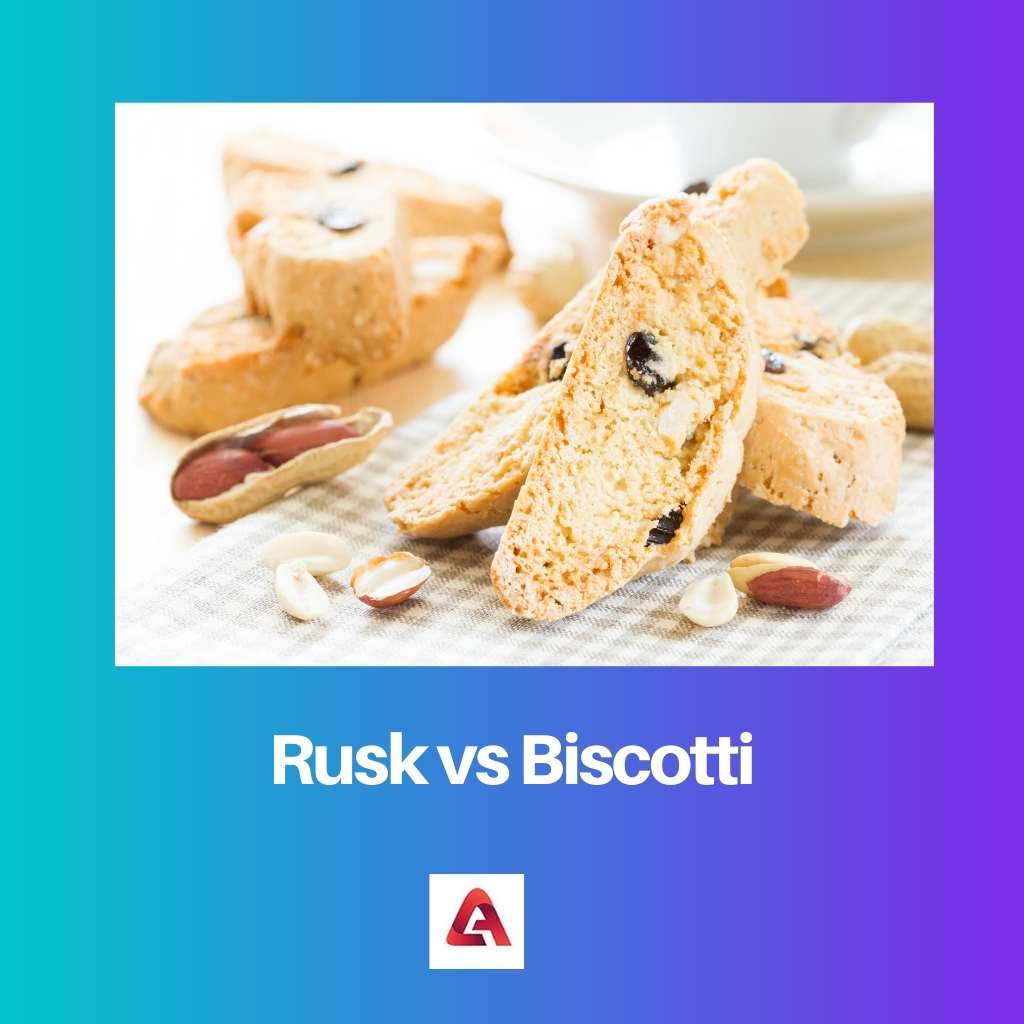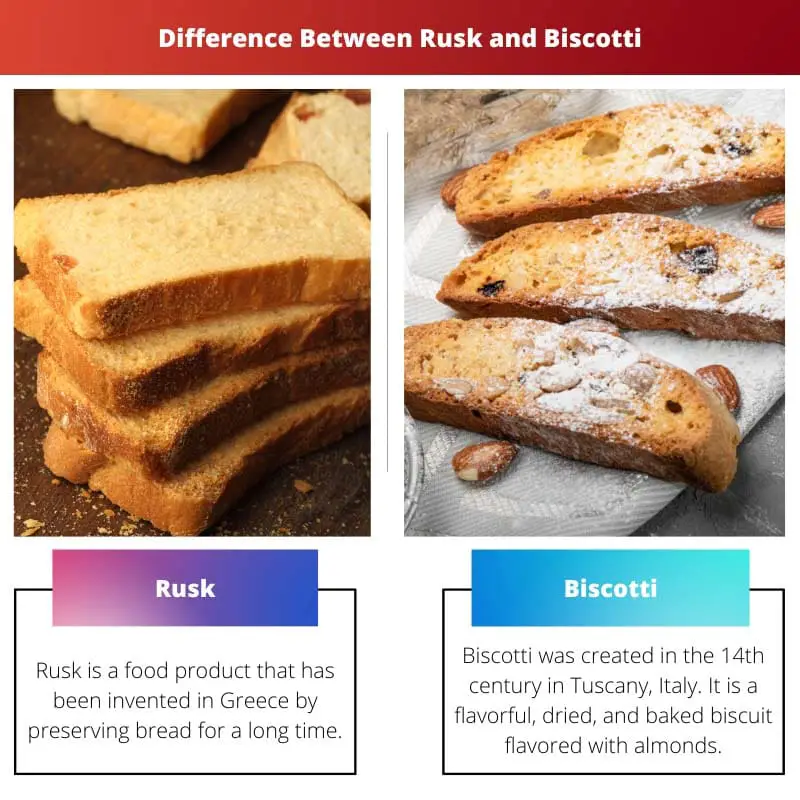Tea lovers enjoy a light snack with tea. Europeans eat sweet and savory food items with their morning and evening tea, such as cakes, pastries, biscuits, sandwiches, rusk, and biscotti.
Rusk and biscotti are two well-known crusty and dry European baking delicacies. Both are enjoyed best in the traditional way by dipping in tea. Moreover, both these crisp snacks are popular in other regions too.
Key Takeaways
- Rusks are twice-baked bread slices, while biscotti are twice-baked Italian cookies made from dough containing nuts or dried fruits.
- Biscotti have a sweeter taste and denser texture than rusks, which are dryer and more bread-like.
- Rusks are popular in various cultures as a teething aid for infants, while adults with coffee or dessert wines enjoy biscotti.
Rusk vs Biscotti
Rusk is a twice-baked bread that is made with a combination of flour, sugar, butter, and eggs. It is denser and harder than biscotti and has a coarser texture. Biscotti is also twice-baked, but it is made with almonds, flour, sugar, eggs, etc then, made into an Italian almond biscuit.

Rusk is a food product that has been invented in Greece by preserving bread for a long time. After that, bread must be baked twice to get rid of the moisture.
Though rusk is a European snack, it is a world-famous snack, especially in India. Moreover, rusk gets soft when dipped in beverages (milk and tea), so it is a good meal for babies without teeth.
Biscotti was created in the 14th century in Tuscany, Italy. It is a flavorful, dried, and baked biscuit flavored with almonds, which are high in protein and healthy fats.
It is an oblong-shaped snack best enjoyed at tea parties. In Italian, biscotti means a small place (small piece of crusty biscuit).
Comparison Table
| Parameters of Comparison | Rusk | Biscotti |
|---|---|---|
| Invented In | Rusk was created in the country of Greece. | Biscotti has been invented in Italy. |
| Base Material | Rusk is made from dried bread. | Biscotti is made from biscuits. |
| Time | Rusk was created in the 7th century. | Biscotti was created later in the 14th century. |
| Discovered By | Paxamos, a baker, was the one who found Rusk. | Biscotti was founded by Amadio Baldanzi, a former baker of Italy. |
| The Flour used | Rusk is made from either semolina or wheat flour. | Biscotti is best made from whole wheat flour. |
What is Rusk?
Rusk is a dry bread that dates back to the seventh century in Europe. Bread pieces are dried first and then baked twice, as mentioned earlier.
It turns crispy to consume after that. It was a technique to preserve bread for a long period by removing the moisture.
It was a popular and light snack while traveling and was a staple meal for soldiers when they went on wars. Moreover, it is also a well-known filler meal for infants without teeth
It can be softened by mixing it with milk or tea and then swallowed. Additionally, it could be ground and turned into powder and mixed into beverages. Rusk is famous worldwide with distinct and unique names in different nations.
It is known as milk toast as a modern name. Rusk is also known as a wheat-based food additive in the United Kingdom. It mostly has mild flavors (cardamom and cinnamon), both the spices are good for digestion.
In most countries, rusk is prepared from either stale bread or bun. However, it is produced from scratch in a few spots via using semolina and wheat flour. It is rectangular and white-brown.
Moreover, in South Africa, rusk is regarded as a fancy snack that is served to the guest during tea time. Even South African love to eat as their light breakfast. These can be purchased in confectionery stores, online stores, or baked at home.

What is Biscotti?
Biscotti is Italian food that was created by Amadio Baldanzi in Prato, Italy, for the first time. It is made from almond flavor biscuits in the 14th century.
Discovering biscotti was a result of the need to produce a snack that could be stored for a long time and was also healthy to eat. It is known as an Italian biscuit.
Moreover, it was a popular snack among the Roman army while going for wars as it was loaded with nutrition. Biscotti means a small piece of food that was baked twice. These are smaller in size than the rusk and has different taste.
The traditional recipe did not include oil, yeast, and other preservatives. Modern biscotti are baked with whole wheat flour and served in cafeterias with cappuccino or latte using various methods and recipes because biscotti is dry to eat.
It includes other nuts too (cashews, seeds, pistachio). Moreover, now preservatives and baking materials are also added to the recipe in North America.
Tea parties in France are incomplete without biscotti as a substitute for rusks. Biscotti is a delightful dessert that is served with dry cakes and other similar foods.
At some places, biscotti goes well with wine. Furthermore, it is traditionally served as a post-dinner dessert in Italy with Tuscan wines (a fortified wine).

Main Differences Between Rusk and Biscotti
- Rusk was discovered beforehand in the seventh century. On the other hand, biscotti was discovered almost after seven centuries.
- Rusk is rectangular. However, biscotti is of oblong-shaped.
- Rusk is larger and enriched with olive oil. On the other hand, oil is not used in preparing biscotti.
- Traditionally, rusk was made from stale bread by baking it twice. On the other side, biscotti was prepared by baking the biscuits.
- The flour used in baking rusk is semolina or wheat. However, the flour used in baking biscotti is whole wheat.
- Rusk dissolved in milk can be swallowed by toothless infants. On the contrary, biscotti cannot be consumed by infants due to the presence of nuts.

- https://link.springer.com/chapter/10.1007/978-1-4757-6809-1_12
- https://www.thinkusadairy.org/assets/documents/Customer%20Site/C3-Using%20Dairy/C3.7-Resources%20and%20Insights/03-Application%20and%20Technical%20Materials/BAKERY_ENG.pdf
